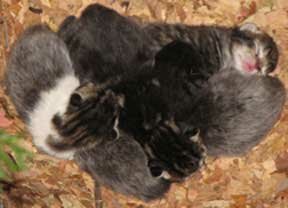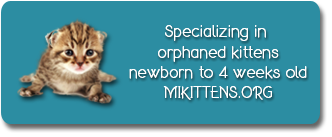Kitten care
What To Do If You Find Orphaned Kittens
If the kittens appear healthy and are in a safe and warm location, observe from afar for a few hours to make sure the mom cat is truly gone. Mom cats can leave the nest for a few hours at a time. Kittens who are calm and quiet with round bellies are likely being fed and in no immediate danger.
If the kittens are in an unsafe location or appear distressed (crying, cold, dirty), bring them inside and follow the emergency kitten care instructions.
A vet visit is recommended as soon as possible to confirm the kitten’s health and medical needs.
Emergency Kitten Care
1. Warmth
The number one concern for an infant kitten is warmth. NEVER attempt to feed a cold kitten – this can cause death. Warm the kitten first.
To safely warm a chilled kitten, use a heating pad wrapped in a towel set on low or a hot water bottle warmed to 100 degrees. Make sure kitten can move away from heat if too warm. If you have neither, pour dry rice or dry beans into a cotton sock and tie a knot. Microwave for 2 minutes (adjust depending on your wattage) and it will stay warm for approximately 30 minutes. Be careful not to burn contents.
You can safely rub light Karo syrup on the kitten’s gums every 15-20 minutes during warming to help.
2. Feeding
Kittens under 3-4 weeks cannot eat on their own and must be bottle or syringe fed. Do not feed cow’s milk. It is not nutritious enough for kittens and will cause diarrhea which can be deadly. Feed a commercially prepared kitten milk replacer such as KMR (preferred) or Just Born. These are available at most pet stores and large retailers.
In an emergency when milk replacer is unavailable, you can use a homemade formula short-term but should switch to a commercial formula asap.
Mix formula and warm to a comfortable temperature, using the inside of your wrist to test. Use a pet bottle, eyedropper or 1-3ml oral syringe to feed, being careful not to squeeze too much formula at once. Never feed kittens on their back! They should be placed on their stomach like they would normally nurse. Pet bottles require a small hole being cut in the nipple. If you turn the bottle upside down and the formula drips slowly in droplets, the hole is the correct size. Insert bottle or syringe into the kitten’s mouth and gently squeeze a small amount of formula in.
Make sure the kitten swallows before squeezing more formula. Some kittens will latch on and suck immediately, others take longer to adjust.
Kittens should eat approximately 8mls of formula per ounce of body weight per day. A 6 ounce kitten requires 48mls of formula daily, divided by the number of feedings. Kittens under a week old should be fed every 2-3 hours. Kittens 1 to 2 weeks old every 3-4 hours, and 3 to 4 week old kittens fed every 5-6 hours.
When a kitten has had enough formula, it will usually get some bubbles around its mouth and its tummy will be very rounded, almost pear-shaped. After feeding, you should burp the kitten just like you’d burp a human baby; hold it upright against your shoulder and rub it on the back.
3. Stimulating
Very young kittens cannot pee or poop without stimulation. Normally mom cat performs this function, but with orphans you must instead.
Take a soft tissue or cotton ball and gently dab the kitten’s genital area. Kittens will usually start peeing immediately. Continue until no more urine is seen. They will not poop every feeding, but should do so once or twice a day. It sometimes takes a few days to see poop after starting a commercial formula, but see a vet if more time passes without defecation.
Stimulation should occur before every meal. Normal urine is light yellow. Darker colors indicate dehydration and the kitten should be seen by a vet immediately. Normal poop color is brown and the consistency soft like toothpaste. Poop that has blood, is light yellow/white or uncontrolled is dangerous and requires a vet visit asap.
For more information regarding orphaned kitten care, visit www.kittenrescue.org or www.kitten-rescue.com.



